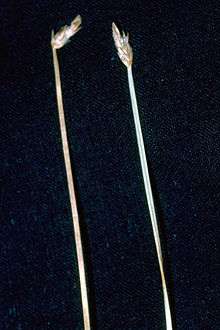Eleocharis rostellata
Eleocharis rostellata is a species of spikesedge known by the common name beaked spikerush. It is widespread across North America (including Mexico, Guatemala and the West Indies), with isolated populations in Argentina.[1][2][3][4]
| Eleocharis rostellata | |
|---|---|
 | |
| Scientific classification | |
| Kingdom: | Plantae |
| Clade: | Tracheophytes |
| Clade: | Angiosperms |
| Clade: | Monocots |
| Clade: | Commelinids |
| Order: | Poales |
| Family: | Cyperaceae |
| Genus: | Eleocharis |
| Species: | E. rostellata |
| Binomial name | |
| Eleocharis rostellata | |
| Synonyms[1] | |
| |
Eleocharis rostellata occurs in many types of wetland habitat, especially saline and alkaline water bodies such as hot springs, fens, and salt marshes.
Description
Eleocharis rostellata is a rhizomatous perennial herb growing up to 1.2 meters tall with spongy, compressible stems. The stem bends and droops and if the tip touches moist soil it may root there and grow more stems.[5] The plant also reproduces by seed and vegetatively by sprouting from bits of rhizome. The inflorescence is a single spikelet up to 2 centimeters long made up of many tiny flowers covered in light brown, sometimes purple-spotted bracts.[6]
References
- Kew World Checklist of Selected Plant Families
- Espejo Serna, A. & López-Ferrari, A.R. (1997). Las Monocotiledóneas Mexicanas una Sinopsis Florística 5: 1-98. Consejo Nacional de la Flora de México, México D.F..
- Acevedo-Rodríguez, P. & Strong, M.T. (2012). Catalogue of seed plants of the West Indies. Smithsonian Contributions to Botany 98: 1-1192.
- Morello, J. 1951. El bosque de Algarrobo y la Estepa de Jarilla en el Valle de Santa Maria (Provincia de Tucuman). Darwiniana 9(3–4): 315–347.
- Forest Service Fire Ecology
- Flora of North America